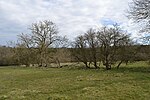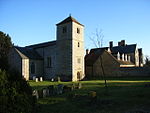Preston Bissett

Preston Bissett is a village and civil parish in the unitary authority area of Buckinghamshire, England. It is about four miles SSW of Buckingham, six miles north east of Bicester in Oxfordshire. The soil is clay and gravel, but the subsoil varies. The parish is watered by a tributary of the River Great Ouse. The toponym "Preston" is common in England; it is derived from the Old English for "priest's farm". The Domesday Book of 1086 records the village as Prestone. The affix "Bissett" came later and refers to the lords of the manor, distinguishing it from other places called Preston. The village has a public house, the White Hart, a playing field, a cricket pitch, garden nurseries and a farm shop. As of 1927, the History of the County of Buckingham described the village as 'picturesque', mainly composed of thatched cottages grouped around the parish church, which in turn stood in a churchyard on rising ground; although it reported there were "a few modern residences" on the east end of the village.
Excerpt from the Wikipedia article Preston Bissett (License: CC BY-SA 3.0, Authors, Images).Preston Bissett
Im Lehrer Feld, Ulm
Geographical coordinates (GPS) Address Nearby Places Show on map
Geographical coordinates (GPS)
| Latitude | Longitude |
|---|---|
| N 51.963 ° | E -1.044 ° |
Address
Carl Walther
Im Lehrer Feld 1
89081 Ulm
Baden-Württemberg, Deutschland
Open on Google Maps










